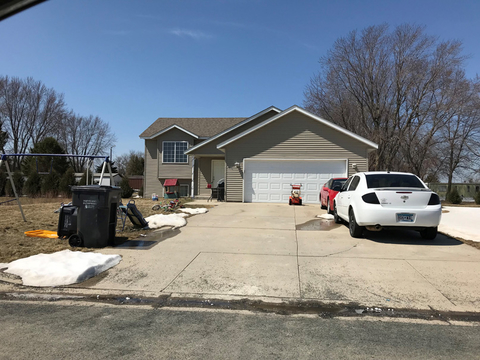Core housing issues addressed
- Housing finance – public and/or private
- Housing stock quality
- Unresponsive housing market
Housing challenges
The biggest challenge Claremont, Minnesota faces is a stall in new single family housing development since 2007. Local contacts say the Great Recession was definitely a factor. When the market dipped, all building stopped. As of this writing (July 2018):
- There is a lack of single family housing.
- There are no recent local single family sales to generate comparable market prices to support lending for new housing development.
This housing challenge is compounded by the fact that the city is small and lacks amenities such as a local grocery store, department store, or pharmacy to attract families to live there. Within a reasonable driving distance of Claremont, large cities such as Rochester, Owatonna, and Faribault have developed retail, service and commercial bases.
The city's former community development director described the issue and factors challenging the community:
- Many in the community are affected.
- The rental market has been maxed out for a long time.
- Existing market rate housing has all been purchased.
- There are additional barriers to building new homes, including a reluctance of low-income families to accept they might need some help. Another barrier is the language used in the community to talk about emerging development. "Farm labor housing" and "new development" is preferred to "affordable housing."
Community Profile
The City of Claremont is located in Dodge County, which is within the Rochester Metropolitan Area. Like many small communities in Greater Minnesota, Claremont struggles to meet the housing needs of different groups of people. The community, located along U.S. Highway 14 in the southeast corner of the state, had a permanent population of 548 in 2010.
Between 2010 and 2015, the total population stayed about the same, but age groups appear to be shifting. The community is getting younger. Working-age adults have established a stronger presence in the community, as have younger children. There is a decrease in the number of older, working-age adults. (See chart below.) Claremont's median age dropped from 33.5 to 32.4 years. Most of the city's children go to school in nearby Dodge Center. The Claremont School District was part of a regional district consolidation in 1992.
With Hispanic residents of any race accounting for 15 percent of the local population, and another 5 percent of local folks representing other races, Claremont is more racially and ethnically diverse than some Greater Minnesota communities. The growth of the city's overall population has been modest during the last 110 years and has stalled in recent decades.
Many Claremont residents work in the cities of Owatonna or Dodge Center. A 2015 estimate suggests that 88 percent of local workers commute in some type of vehicle to their workplace. With an average commute time of 34 minutes, and a city footprint of less than one square mile, we can assume many Claremont locals are employed outside the city. Looking at Claremont's employment numbers by "place of work"—not where residents work, but jobs located in Claremont—we see 247 employees. Sixty percent are working in key industries such as manufacturing, retail, education, health care and social services, and construction.
Core drivers within the city's economy include its role as a hub for agricultural services and agriculture-related energy production.
Housing Success Story
The city of Claremont created a subdivision, The Claremont Development, to invite different local housing solutions. The property is open and offers incentives to any market rate or project that meets expectations and follows the city's building covenants.
One unique project partnership has evolved to address Claremont's challenges. It includes partners from multiple jurisdictions, as well as nonprofits and market-driven partners. Each partner played a key role in developing a single family home for working families. Here is the unique process adopted and the role of each partner for one of these lots:
- The City of Claremont owns single-family lots in The Claremont Development subdivision for the purpose of encouraging home construction for families. The city sells the lots below market rate for qualifying families. Depending on a given family's income level by family size, a lot price can vary from free to $9,500. Outside of this family-oriented housing program, a city lot costs more than $25,000.
- In 2017, the city's economic development authority set a goal to build two new units in the subdivision.
- The lots are serviced with sewer, water, and gas—resulting from a project that stalled in the early stages of the Great Recession.
- Keller Williams Premier Realty is marketing this housing opportunity. The city has offered an open invitation to area realtors to handle listings.
- When a low-income family is considered for a housing project in The Claremont Development, the relationships developed between Habitat for Humanity, Citizens State Bank, and the U.S. Department of Agriculture's Office of Rural Development can assist them in more easily affording and building a home in the subdivision.
- Rochester Habitat for Humanity helps families gauge—or evaluate—income eligibility.
- Once a family is pre-qualified by Habitat for Humanity and Rural Development, Habitat applies for a construction loan from Citizens State Bank. This helps the bank meet its Community Reinvestment Act (CRA) goals. The CRA is a federal law that encourages local investment in meeting the housing and community development credit needs of families from all income levels.
- The family then applies for a Section 502 Direct Loan from the U.S. Department of Agriculture's Rural Development program. Section 502 loans help qualified, low-income families pay reduced payments on their mortgages.
- Once the house is constructed, Habitat transfers ownership to the family and the family finances via the 502 Direct Loan.
- Payments on construction loans go into a Revolving Fund to support funding for a future family housing project.
- Each family is assigned a mentor by Habitat and receives homeownership counseling.
The approach above is just one example of how the city encourages the building of houses for working families in Claremont. Any type of financing may be used or none at all.
Who can you follow up with to learn more or to clarify housing project details?
Marie Lindblom, city administrator, City of Claremont
Phone: 507-528-2137 | Email Address: administrator@claremontmn.com
Casey Hatch, broker/realtor
Phone: 507-438-3342 | Email Address: CaseyHatch@kw.com
About the MN Rural Housing study
Small rural communities in Minnesota face persistent housing challenges. In 2017, the state's regional development organizations (RODs) identified housing as a top learning focus and called for the creation of case studies that highlight creative solutions to persistent housing issues confronting smaller communities. The project is a collaboration between the University of Minnesota Extension Department of Community Development and the Center for Small Towns. It is jointly funded by the federally-funded Economic Development Administration (EDA) Center at University of Minnesota at Crookston and University of Minnesota's Extension Department of Community Development.
- Google Maps, 2017
- Interviews with city staff, 2017
- American Community Survey (ACS), 2011-2015
- U.S. Decennial Census, 2010
- Photos provided by city staff, 2018
Reviewed in 2018






